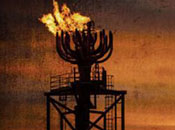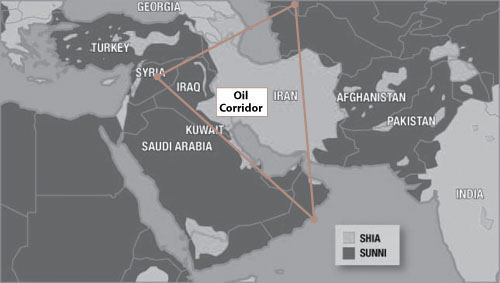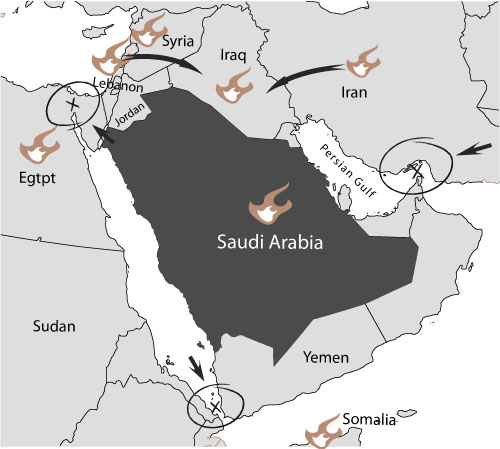
The recent conflict in Syria is fanning flames across the entire Middle East. It's another tragic, gruesome aspect of the "Oil Wars" scenario that I've developed in these pages over the past few years.
For now, the heat has died down and Pres. Obama has postponed airstrikes against Syrian targets. But there's no telling where things will stand a few weeks from now. Either way, the whole area is ugly, and could get uglier in a hurry.
As an investor, you need to move away from this looming conflagration! Expanding Middle East conflict has the potential to drive global energy prices through the roof. Thus, you want to preserve your wealth in the days to come and angle toward the best prospects for future gains in a tumultuous world. I'll give you my best ideas in this article. . .
The Middle East is a hotbed of religious strife, and I do NOT just mean the shopworn list of contentions between the Jewish state of Israel and its Arab-Islamic neighbors. No, I'm referring to the long-standing divide between two main factions of Islam, Sunni and Shia. These two factions seethe with hatreds that go back to the founding of Islam in the seventh century.
Iran (for many millennia called Persia) is predominantly Shiite. Meanwhile, numerous Arab nations in the region are mostly Sunni, but with large Shiite areas in strategic locales.
What do I mean by strategic?
Take a look at the map below. You can see a breakdown of the territory the two factions control, centered on what I call the "oil corridor," which spans the bottom of the Arabian Peninsula up into the southern reaches of the former Soviet Union:

Looking at the map, it's clear that many of the largest oil-producing areas in the Middle East are in Shiite-dominated jurisdictions. This is certainly the case with Iran. That, and Shiite domination is also the case for many major oil fields of the Kingdom of Saudi Arabia (KSA) and Iraq, as well as up into the "Stans" of the former Soviet Union—source of many a jihadist warrior, not coincidentally.
Now let's look at larger patterns of conflict across the Middle East using the world's largest petro state, Saudi Arabia, as the focus. Here's the map, and I'll explain the flaming symbols in a moment:

Look at the world from the Saudi/Sunni perspective. Virtually all Saudi oil exports pass through what navy people call geographic "choke points." That is, tankers pass through narrow oceanic zones that are subject to closure or make for relatively easy attack.
For the kingdom of Saudi Arabia (KSA), the problem begins with the Strait of Hormuz in the east, where Iran could make quick mischief if the mullahs were so moved. To the south, KSA is hemmed in by the narrow opening of the Red Sea. To the northwest, Saudi sea access is limited by the need to travel through the Suez Canal. Thus, right away, KSA has a strategic issue with access for its oil to world markets.
Over and above the maritime choke points, eastern KSA oil fields are populated by Shiite groups with questionable loyalty to the Saudi government. How bad are things? Well, for many decades, Shiites have been barred from serving in the Saudi army or a parallel internal paramilitary organization called the Saudi Arabian National Guard. The top Saudi people simply don't trust the Shiites.
Just across the gulf from Saudi Arabia to the northeast is Shiite Iran, a traditional rival to KSA in all manner of geopolitical issues. Directly north of KSA is Iraq, and in the aftermath of U.S. withdrawal, there's new and growing Iranian influence there as well.
To the northwest of KSA is the entire mess of Syria-Lebanon, where Iran and Russia support the Syrian government as a client state. Meanwhile, also northwest, Israel is hardly an ally of the Saudis, although there's more of a modus vivendi between the two nations than most people think or either nation likes to advertise.
To the west, across the Red Sea from KSA, Egypt is in turmoil. Saudi leaders have made no secret of their dislike for the now deposed Egyptian Muslim Brotherhood, whose brand of Islam has long made trouble for KSA rulers, within Saudi Arabia and across the globe. As things now stand, Saudi sheiks are bankers to Egypt's military government, paying for most day-to-day operations as well as large imports of food and fuel to Egypt.
To the south of KSA, Yemen is a hotbed of anti-Saudi activity. Press reports state that the Saudis permit U.S. drones to operate from Saudi territory and fly over Yemen to blast insurgents. That, and KSA has configured much of its military to fight against Yemeni forces, to include direct airstrikes and ground combat against Yemeni insurgents in the past few years.
The point is that Saudi Arabia—essential to the global oil supply—is surrounded by strategic choke points as well as restive groups of Shiites. Entire populations and Islamic sects across the Middle East want to see KSA go down, either through internal strife or external meddling. And if that happens, it could instantly drive oil prices much higher.
Of course, the Saudi ruling class is savvy to all of these issues. KSA has strong military forces, as well as the above-noted National Guard to keep the peace internally. That, and KSA has a remarkably good intelligence capability based on excellent development of personal contacts across the Middle East and throughout the world.
Still, if conflict in Syrian or other Middle East hotspots escalate, risks climb. If the U.S. shoots missiles or drops bombs, all bets are off. As I said above, it could get ugly in a hurry.
In Syria, the Saudis have backed the rebels who fight against that nation's government. In the event that the rebels lose—which is likely, sooner or later—it will be a major strategic and policy disaster for the Saudi government. And then, there's no predicting exactly what might happen next within KSA, along its borders, at its strategic choke points or in any other respect.
If bad things happen to Middle East oil exports—certainly if something bad happens inside KSA—stand by for global oil disruptions and price spikes. Oil will quickly cost more, and the price you pay at the pump will soar.
You should invest away from the turmoil in the Middle East. Focus your energy portfolio far from the ancient strife and oil wars of that region.
What are some of the best ideas? Well, current oil price levels support strong drilling programs in North America and across the world. I expect continuing, long-term support for North American land drillers as well as drill pipe makers.
Long term, prospects for oil service companies are excellent—my paid-up readers have long-known my "trifecta" of favorite oil service plays. Indeed, as oil continues to command a premium price, worldwide, the service companies that help bring oil to the surface stand to make a buck.
Then there are the offshore plays, far from the fighting of the Middle East. Deepwater oil production is one of the last great frontiers for global oil production. In the medium to long-term I expect great things from offshore oil.
One final point. For as well as the offshore space has performed since the BP blowout in 2010, there's much more still to come. That is, development in the U.S. offshore space is highly restricted by federal policy. Indeed, only a small portion of the U.S offshore is open for leasing. The rest is what I call the "No Zone."
When (not "if") things get even worse in the Middle East and oil prices soar, we'll see public pressures to open up large new areas of the U.S. offshore space. The unintended consequence of impending disaster in the Middle East will at least serve the beneficial purpose of forcing the U.S. government, policy and media elite to construct a coherent narrative about what's happening to the nation—or so I hope.
Byron King
Daily Reckoning

























































